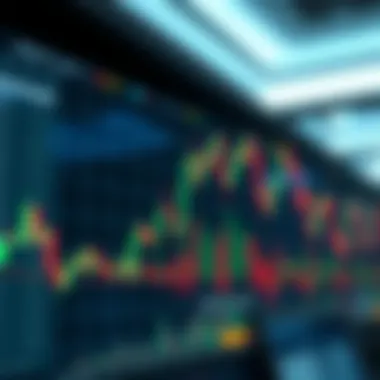Mastering Candlestick Patterns in Crypto Trading


Intro
The world of cryptocurrency trading offers more than just financial opportunities; it also presents a complex tapestry of human behavior and market sentiment. Understanding candlestick patterns, essential tools for any trader, can provide insights into price movements and potential reversals. But before diving into candlestick formations, a fundamental grasp of cryptocurrencies and market behavior is crucial. This section sets the stage for interpreting these patterns effectively, illustrating how they connect with broader market trends and investor psychology.
The Fundamentals of Candlestick Charts
Understanding candlestick charts is a pivotal aspect of cryptocurrency trading. These charts are not just a collection of colorful graphics; they tell a story of price movements, trader behavior, and market sentiment over a specific period. Knowing how to read these charts effectively can jumpstart your trading strategy and offer you insights that raw numbers alone cannot provide.
Understanding the Structure of a Candlestick
Candlesticks consist of four main elements that interact to illustrate price behavior: open, close, high, and low. Grasping these elements is vital to interpreting the market accurately.
Open, Close, High, Low
The open is the first price traded during a specific time period, while the close represents the last price. The high and low prices reflect the maximum and minimum during that time frame. This is crucial in identifying trends — if a candle closes higher than the open, it signals buying strength. Conversely, if the close is lower, it indicates selling pressure. This characteristic makes them a preferred tool for traders seeking to discern momentum in the crypto market. The unique aspect lies in how the relationship between these prices can reveal shifts in market sentiment. A wick, the line extending from the body, offers additional insight, as it showcases price rejection.
Body and Wick Dynamics
The body of the candlestick portrays the difference between the open and close prices, giving a visual cue of market activity. Wicks, the lines above and below the body, indicate price fluctuations outside of those bounds. The dynamic nature of these elements sheds light on market volatility. For instance, a long wick suggests price rejection at that level, while a small body indicates indecision. This duality can be advantageous for discerning potential entry points. Traders gravitate towards this structured information, as it simplifies the complexity of price behavior into these recognizable patterns.
Color Interpretation
The color of a candlestick can express critical information about the market's mood. Typically, a green or white candlestick signifies a price increase, while a red or black candlestick indicates a decrease. This simple color coding allows traders to quickly gauge the sentiment. Yet, this interpretation can have its pitfalls — for instance, a green candle may appear bullish, but context is key. A significant move upwards can be less meaningful if it is part of a broader downtrend. Understanding the nuances in color interpretation adds depth to a trader’s analysis.
Historical Context and Usage
History offers valuable lessons in market behavior, and candlestick patterns have a rich lineage that can enhance our grasp of modern trading tactics. By tracing their origins and noting their adaptations in the cryptocurrency space, we bolster our understanding of their importance.
Origins in Traditional Markets
Candlestick charts date back to 18th century Japan, primarily used for rice trading. The clever use of visual data representation made it easier for traders to assess market behavior quickly. This background gives a sense of historical credibility and highlights the enduring relevance of candlestick charts in various markets, including today’s crypto exchanges.
Adoption in Cryptocurrency Trading
With the rise of cryptocurrencies, candlestick patterns have found a new application. Traders in the relatively nascent crypto markets leverage these patterns for their ability to signal buying and selling opportunities among highly volatile assets. This adoption reflects the continued evolution of trading methodologies and the applicability of time-tested tools in new domains. However, while these patterns are valuable, they shouldn't be viewed in isolation; the volatile nature of cryptocurrencies necessitates a broader approach.
Comparison with Other Chart Types
In the diverse toolbox of technical analysis, candlestick charts stand apart from line or bar charts. Unlike a line chart that merely connects closing prices, a candlestick chart presents a fuller picture by displaying open, close, high, and low within each set timeframe. This richness in detail aids traders in making more informed decisions. Each type of chart has its advantages, but the depth provided by candlesticks can often lead to earlier recognition of potential reversals and trend continuations.
Key Candlestick Patterns to Watch
Understanding key candlestick patterns is vital for anyone dabbling in cryptocurrency trading. The volatility associated with the crypto market can throw a wrench into even the best-laid plans. Recognizing these patterns not only enhances one’s analytical skills but also supports better decision-making. Traders can pinpoint potential reversals and continuations in market trends that may not be immediately obvious at first glance. By honing in on these patterns, a trader develops a sharper sense of timing, leading to more strategic entries and exits.
Single Candlestick Patterns
Doji Candlesticks
The Doji candlestick stands out in the jungle of trading signals for its unique formation. It appears when the open and close prices are nearly the same, leading to a small body with long wicks. This setup acts as a moment of indecision in the market. As a result, the presence of a Doji often hints at the possibility of a trend reversal. Traders value this pattern due to its capacity to represent market uncertainty, making it a particularly crucial sign to watch during periods of price fluctuation. One downside, however, is that the Doji alone may not provide a definitive indication of trend direction; often, additional confirmation from subsequent candlesticks is needed before making trading decisions.
Hammer and Hanging Man
The Hammer and Hanging Man patterns both feature a small body and long lower shadow, but their implications differ based on their context. The Hammer appears at the bottom of a downtrend and suggests potential bullish reversal, while the Hanging Man shows up at the top of an uptrend, signaling a bearish turn ahead. What makes these patterns particularly useful for traders is that they are reliable indicators of potential market changes. However, they need to be treated with caution if they appear in isolation, as their predictive power can diminish without backup signals from other patterns or indicators.


Inverted Hammer
The Inverted Hammer is another signal that warrants attention, especially for those looking for bullish opportunities. Its formation resembles that of the Hammer but is inverted – featuring a small body with a long upper wick. Typically found at the bottom of a downtrend, it points to a possible price reversal. This candlestick pattern informs traders that buyers are starting to step in, despite sellers trying to push prices down. Using the Inverted Hammer, though, requires careful consideration of the subsequent price action, as its efficacy significantly enhances when observed in conjunction with bullish confirmations from other indicators or patterns.
Multiple Candlestick Patterns
Engulfing Patterns
Engulfing Patterns are powerful indicators that signal potential reversals. The Bullish Engulfing pattern occurs when a smaller bearish candle is followed by a larger bullish candle, swallowing the previous one whole, whereas the Bearish Engulfing pattern reverses this. What traders appreciate about Engulfing Patterns is their ability to indicate strong momentum shifts, suggesting that buyers or sellers are gaining ground. They serve as a litmus test of market sentiment, turning indecision into clarity. The main caveat is that the presence of other confirming indicators should ideally accompany them for better accuracy.
Morning and Evening Stars
These star patterns are renowned for their clear indication of market reversals. A Morning Star consists of three candles: a bearish candle, a small-bodied candle, and a bullish candle. This formation suggests a shift from selling pressure to buying momentum. Conversely, in an Evening Star, the setup is inverted, signaling a potential downturn. The strength of both patterns lies in their visual clarity and the way they can encapsulate shifts in market psychology. However, relying on their signals without looking at broader market contexts can lead to misguided trades.
Shooting Star
The Shooting Star is a distinct formation that traders often use as a signal for a bearish reversal. It comprises a small body located at the lower end of the session range with a long upper wick. This setup typically occurs at market tops, where the price initially advances sharply but then fails to hold onto those gains, indicating that sellers are starting to push back. While a Shooting Star can be a strong warning sign, relying solely on it without considering other technical indicators may not yield the best results, as false signals can occur when the market shows high volatility.
Interpreting Candlestick Patterns in Context
When it comes to understanding candlestick patterns in cryptocurrency trading, context holds the key. It’s not just about shapes and colors on the chart; it's the nuanced interplay of market sentiment, psychology, global events, and local trends that breathe life into these patterns. Grasping this context helps traders make informed decisions, as it provides clarity on potential price movements and trading opportunities. Unpacking these relationships can significantly enhance a trader's ability to navigate the often volatile waters of crypto markets.
Market Sentiment and Psychology
Bearish vs. Bullish Indicators
Bearish and bullish indicators play a crucial role in guiding traders. Bearish indicators suggest a downward trend and can act as a warning sign for investors, while bullish indicators point towards potential gains. Recognizing these signals gives traders the ability to align their strategies according to market trends.
The primary characteristic of these indicators lies in their anticipatory nature. They give insights into possible market direction, aiding traders in timing entries and exits more effectively. A powerful aspect of bearish and bullish indicators is that even novices can start integrating them into their trading modus operandi quickly. However, it’s essential to remember that these indicators are not foolproof. They can mislead if traders rely solely on them without considering broader market trends.
How Emotion Drives Market Movements
Understanding how emotion influences market movements can be the difference between a wise decision and a detrimental misstep. Fear and greed are two major players in this arena; they dictate trading patterns and can cause sudden price swings. When investors feel optimistic, they are likely to buy more, leading to increased prices. On the contrary, panic selling during a downturn can trigger sharp declines in value.
The key takeaway here is the reciprocal nature of fear and greed, and their visceral impact on market dynamics. This emotional undercurrent is crucial for traders to recognize. It emphasizes the necessity for a balanced approach, relying on emotional intelligence along with technical analysis. While this might seem subjective, observing emotional patterns in trading can provide a stronger edge when applied alongside candlestick readings.
Volume Indicators and Their Importance
Volume indicators serve as a backbone for interpreting candlestick patterns. They measure the number of shares or contracts traded in a security or market during a specified period and provide valuable context to price movements. When coupled with candlesticks, volume can confirm trends, suggesting whether a price movement is genuine or just noise.
A remarkable quality of volume indicators is their ability to highlight market strength behind a price movement. For example, if a price breakout occurs alongside high volume, it signals strong participation and commitment to the trend, increasing the likelihood of sustainable price action. However, relying too heavily on volume without considering other factors can lead to a false sense of security or missed opportunities.
Think Globally, Act Locally
Influence of Global Events on Price Action
Global events can dramatically impact cryptocurrency markets, often sending ripples that reach traders in unexpected ways. Events such as economic reports, political instability, or international regulations can sway prices significantly. Keeping an eye on global news can offer insights that are vital for interpreting candlestick formations in real-time.
The defining feature of global events is their far-reaching implications. A piece of news one corner of the world can send Bitcoin prices soaring or plummeting elsewhere. This underscores the importance of being connected to global economic narratives that tie back to market action directly. However, these influences can sometimes be fleeting, leading traders to balance immediate reactions with broader market analysis.
Local Trends and Their Implications
Local trends often reflect the sentiments and behaviors of a specific demographic or trading group. Understanding these is fundamental for anyone closely involved in a certain market area, especially smaller cryptocurrencies that can be heavily influenced by localized factors.
The notable characteristic of local trends is their potential to override broader market suggestions. For example, a regional regulatory change can spur bullish sentiment, allowing traders to capitalize on fluctuations before larger market forces react. However, local trends may not always be indicative of long-term price sustainability, which can lead to speculative trading. This makes it essential for traders to gather local insights while remaining mindful of the global landscape.


Integrating News Analysis with Candlestick Reading
News analysis provides context and depth to candlestick readings, making it quite practical for traders wishing to improve their strategies. Understanding how breaking news correlates with candle patterns helps in formulating responses to market changes. Integrating news with candlestick analysis can open new dimensions in interpreting price movements, allowing traders to anticipate shifts more accurately.
The distinctive element of this integration lies in its ability to foster comprehensive understanding. When traders correlate real-time news with candlestick formations, they have a better chance of foreseeing trends or reversals. Nonetheless, constantly consuming news can become overwhelming, leading to analysis paralysis. Keeping a sharp focus and filtering relevant news is crucial for maintaining a clear trading strategy.
In sum, interpreting candlestick patterns within their context is not merely important but essential for any trader aspiring to succeed in the cryptocurrency space. Understanding market sentiment, psychology, local trends, and the relevance of global events allows for a more thorough and effective approach to trading.
Practical Applications of Candlestick Readings
Candlestick readings not only offer a visual representation of price movements in cryptocurrency trading but also serve as a cornerstone for effective trading strategies. Understanding how to practically apply these readings can significantly enhance decision-making processes and improve overall trading performance. In today’s fast-paced market, where emotions often swing like a pendulum, having a structured approach can be the difference between profit and loss. This section highlights the critical components of integrating candlestick analysis into practical trading applications.
Developing a Trading Strategy
Combining Indicators for Enhanced Accuracy
Combining various indicators with candlestick patterns is akin to having a multifaceted lens through which traders can view the market. When executed properly, this approach results in actionable insights, enhancing the accuracy of predictions. Traders often blend oscillators like the Relative Strength Index (RSI) with candlestick patterns to confirm potential reversals or trend continuations. This method can offer a layer of validation, reducing the likelihood of erroneous decisions based purely on a single indicator.
Moreover, there’s a key benefit in using multiple indicators: it allows traders to identify trends or market health more comprehensively. However, one needs to tread carefully. Overcomplicating the analysis with too many indicators can lead to analysis paralysis, making it hard to act promptly. Another aspect to consider is the unique interplay of different indicators and candlestick patterns, which can either bolster confidence in a trading choice or contradict each other, necessitating astute judgment.
Risk Management Techniques
Risk management is an indispensable part of trading strategy—akin to wearing a seatbelt in a car. This can protect traders from significant losses during adverse market movements. Techniques such as setting stop-loss orders and determining position sizes based on risk tolerance are commonplace. These strategies work hand-in-hand with candlestick analysis, allowing traders to identify potential exit points more effectively.
One of the key characteristics of robust risk management is the use of a risk-reward ratio. A well-defined ratio can guide traders in their decision-making, keeping emotions at bay during the inevitable ups and downs of trading. Yet even the best risk management strategies have their drawbacks. Relying solely on historical data can often mislead the trader when unforeseen events—like regulatory changes or market crashes—occur. Hence, it's beneficial to combine risk techniques with continuous market awareness.
Setting Entry and Exit Points
Setting entry and exit points is vital; it serves as the roadmap for a trader navigating the often tumultuous waters of cryptocurrency markets. The entry point is where a trader decides to buy or sell an asset, while the exit point is the juncture at which they close their position. Candlestick patterns can signal these critical moments effectively, providing insights into potential reversals or continuations.
Having a clear plan for entry and exit can lead to more disciplined trading. A common approach is using candlestick confirmations to validate these decisions; for instance, a bullish engulfing pattern might suggest a prime entry opportunity. However, one must consider the context of the candlestick—the broader market environment, news events, and prevailing sentiment—because a pattern in isolation can be misleading.
This leads into a seemingly paradoxical aspect: while setting defined points is critical, the ability to adapt to emerging information in the market cannot be understated. Successful traders often find the balance between sticking to their predefined strategies and allowing for flexibility as the market evolves.
Tools and Platforms for Analysis
Top Trading Platforms for Candlestick Analysis
When it comes to analyzing candlestick patterns, the choice of trading platform plays an essential role. Platforms such as Binance and Coinbase offer integrated charting tools that visualize candlestick patterns effectively. Users can customize their charts, add multiple time frames, and employ various technical indicators to tailor their analyses to individual needs.
A hallmark feature of these platforms is their responsiveness—allowing users to act quickly on signals derived from candlestick patterns. However, it’s essential to remain aware of the potential for technical glitches or latency during high volatility, which could disrupt trading decisions. Overall, choosing the right platform can enhance a trader's ability to interpret candlestick patterns promptly and accurately.
Charting Software Options
In addition to trading platforms, charting software like TradingView and Coinigy provides robust tools for detailed analysis. These options usually offer advanced features, such as back-testing capabilities and extensive libraries of indicators. Traders can go one step further by customizing their charts based on personal preferences, using various timeframes and integrating fundamentals into their candlestick analysis.
While these tools are powerful, there are trade-offs in terms of cost and complexity. Subscription fees may become a factor, and on some platforms, a steep learning curve might await newcomers. Nevertheless, the depth of analysis possible with such software often outweighs these challenges for serious traders.
Mobile Apps for On-the-Go Trading
As trading continues to become more mobile, several applications are tailored for on-the-go candlestick analysis. Apps like Crypto Pro and Blockfolio allow traders to monitor price fluctuations and analyze candlestick patterns even while away from their desktops. Having such functionality can be a game changer, enabling trades based on real-time data.
The primary advantage of mobile apps is convenience. However, they can fall short in terms of providing the comprehensive tools found on desktop platforms. Thus, a trader relying solely on mobile apps may sacrifice some level of in-depth analysis. Ultimately, they are a fantastic supplement, ensuring that traders remain connected and adaptable to market changes, regardless of their location.


By thoroughly understanding the practical applications of candlestick readings, traders can develop more informed strategies that encompass a variety of elements ranging from risk management to tool selection.
Common Pitfalls in Candlestick Analysis
Understanding the pitfalls of candlestick analysis is crucial for traders navigating the unpredictable waters of cryptocurrency. As beneficial as candlestick patterns can be, their effectiveness can quickly diminish if traders fall into certain traps. Recognizing these common mistakes can bolster a trader's decision-making process and lead to more consistent results.
Overreliance on Patterns
Understanding Market Noise
Market noise refers to the random movements and fluctuations that don’t reflect the true condition of the market. This noise can create misleading signals, causing traders to misinterpret the patterns formed on candlestick charts. Traders focusing solely on candlestick patterns without considering this noise may find themselves embarking on treacherous trades. While technical patterns can provide valuable insights, it's essential to marry them with broader market contexts. The unique feature of market noise is its capacity to mislead even seasoned investors, revealing the risks of undue reliance on candlestick formations alone. This understanding helps traders to better filter actual market signals from mere noise.
Interpreting False Signals
False signals are another foe that traders must confront while charting candlestick patterns. These signals occur when a candlestick formation appears to indicate a certain market movement but is then invalidated by subsequent price action. Recognizing this characteristic can save traders from entering bad trades, as often industry conditions change quickly. The phenomenon of false signals is often exacerbated in cryptocurrency trading, where volatility reigns supreme. Here, comprehensive analysis becomes a trader’s best friend, allowing for better contextual interpretation of patterns. Without this broader perspective, traders may find themselves caught in a cycle of heartbreak and lost capital.
Real-World Examples
Examining real-world examples can provide vital clarity regarding the pitfalls of candlestick analysis. For instance, in a recent market event, a trader relied extensively on a hammer pattern that was formed at the bottom of a price drop. Instead of waiting for confirmation through further price action, the trader executed a buy order prematurely. Unfortunately, the subsequent price action took a downturn, leading to significant losses. This situation highlights that while patterns can indicate potential turning points, acting on them without additional validation can lead to harsh consequences. Real-world illustrations serve to underscore the need for cautious trading practices that amalgamate a variety of analysis tools and contextual market understanding.
Neglecting Broader Market Trends
Limitations of Technical Analysis
Technical analysis has its place in trading; however, its limitations cannot be overstated. Traders often lean on charts to make decisions, but neglecting the underlying trends can lead to missteps. For example, even if a bullish pattern appears on a candlestick chart, it may fail to materialize in a bear market. The key characteristic here is recognizing how external variables, such as news events or shifts in market sentiment, can drastically alter expected outcomes. Acknowledging these limitations helps shape more robust trading strategies, ensuring they are adaptable rather than rigidly dependent on past performance.
Integrating Fundamental Analysis
Integrating fundamental analysis alongside candlestick patterns offers a pathway to more informed trading. Traders need to consider factors such as market news, economic indicators, and events that may impact cryptocurrency values. By understanding this aspect, they can evaluate the significance of candlestick patterns in their trading context. This comprehensive view allows traders to develop a holistic perspective, marrying technical with fundamental data to strengthen decision-making strategies. Without this approach, traders might miss critical indicators that could provide a fuller picture of potential price action.
The Role of Market Trends in Strategy
Finally, acknowledging market trends is vital when devising a trading strategy. Trends indicate the general direction in which the market is moving, dictating the effectiveness of the patterns traders may be observing. For example, during a prolonged bull market, a bullish engulfing pattern may hold true stronger than in stagnant or downward conditions. Understanding the dynamics of market trends enables traders to adjust their strategies accordingly, aligning their candlestick interpretations with broader market realities. A strategy that takes market trends into account is likely to be much more resilient than one that relies solely on sporadic patterns.
In summary, candlestick analysis presents a potent tool for cryptocurrency traders, yet it's laden with potential pitfalls. Developing a more nuanced understanding of these challenges can significantly enhance one’s trading strategy. The key is to maintain a balance between technical patterns and broader market contexts.
The End and Future Directions
As we wind down this exploration of candlestick patterns in cryptocurrency trading, it becomes clear that understanding these visual representations of price movements is crucial for anyone looking to navigate the murky waters of digital assets effectively. It’s not simply about reading lines and colors on a chart; it’s about decoding the market’s heartbeat, and that takes both skill and awareness of the ever-evolving landscape.
The Evolving Landscape of Cryptocurrency Trading
The Importance of Adaptability
Adapting to changes in the cryptocurrency market is paramount. The volatility that characterizes this space demands that traders remain fluid in their strategies. Market conditions can shift quicker than a wink, and what works today might be obsolete tomorrow. This adaptability allows traders to respond to unexpected events, be it regulatory news, technological advancements, or shifts in investor sentiment. By staying open to change, traders can reposition themselves and their strategies to grasp new opportunities as they arise.
Key to this adaptability is the understanding that no one trading strategy is fool-proof. The ability to pivot and analyze new candlestick patterns or market signals directly correlates with success rates. Adapting does not mean abandoning one’s core strategy; rather, it means integrating fresh insights into existing practices, thus enhancing decision-making and potentially improving profit margins.
Emerging Technologies and Their Impact
Emerging technologies have become a driving force in reshaping how traders analyze and predict market movements. Tools like artificial intelligence and machine learning are starting to find a foothold in trading practices. These technologies allow for more refined analysis of candlestick patterns, considering a multitude of factors in a fraction of the time that manual analysis would require.
Such advancements provide traders with the unique advantage of processing vast amounts of data, leading to more informed decision-making. However, the downside lies in the potential for over-reliance on these automated solutions. While technology streamlines analyses and uncovers hidden patterns, it cannot completely replace human intuition and experience.
Continued Learning and Resources
The journey of mastering candlestick patterns is not a destination; it's a continuous path filled with new insights and strategies. Continued learning is essential as the market is in a constant state of flux. Engaging with online courses, webinars, and forums can provide invaluable new techniques and perspectives to seasoned traders as well as newcomers.
Resources like Investopedia, Cambridge University’s trading courses, and online trading communities offer endless opportunities for education. The crucial aspect, however, is to remain critical of the information consumed, carefully discerning credible sources from the noise in the crowded digital marketplace.
"In the world of trading, standing still is falling behind. The market doesn’t wait for anyone. Adapt or be left in the dust."















